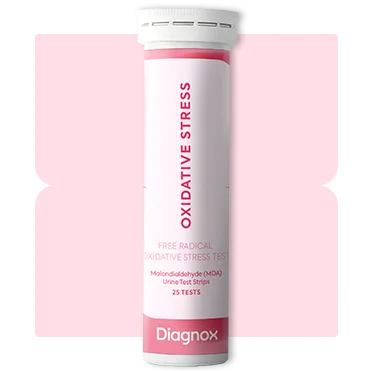How to Measure Oxidative Stress
Since oxidative stress happens inside your cells, you can’t measure it with a thermometer or a blood pressure cuff. But here’s the good news: You can test it by measuring Malondialdehyde (MDA) levels—one of the best biomarkers of oxidative damage.
Malondialdehyde (MDA) as a Measurement of Oxidative Stress
MDA forms when free radicals break down cell membranes. The more MDA in your body, the more oxidative stress you deal with [5-7]. Because this process happens when oxidative stress is high, MDA is considered a biomarker for oxidative damage. Elevated MDA levels in urine or blood indicate that the body is experiencing excess free radical activity, which has been linked to aging, heart disease, diabetes, neurodegenerative disorders, and cancer [4-6].
Regular testing helps you see if your lifestyle changes—like diet, sleep, or stress management—are making a real difference.
If levels are consistently high, it may be a sign that lifestyle factors—such as poor diet, pollution exposure, smoking, or chronic stress—are contributing to excessive oxidative damage. Monitoring these levels over time can also reveal whether healthy changes, like increasing antioxidant intake or reducing environmental toxin exposure, are making a difference [6].
Test at Home with the Diagnox Oxidative Stress Test
The Diagnox Oxidative Stress Test measures MDA levels in urine, making it an easy, at-home way to check your oxidative stress levels. Higher MDA levels mean more free radical activity, and tracking it over time helps you see if your lifestyle changes are making a difference [7-8].
Now that we understand oxidative stress, its causes, and how to measure it, let's explore practical tips to reduce free radical damage.
How to Reduce Oxidative Stress?
Oxidative stress cannot be eliminated entirely, but with the right habits, it can be kept in check.
1. Eat More Antioxidant-Rich Foods
Antioxidants neutralize free radicals before they cause damage. Here’s where to get them:
- Berries (blueberries, pomegranates, grapes) - Packed with vitamin C & anthocyanins.
- Leafy greens (spinach, kale, broccoli) - Loaded with antioxidants & phytonutrients.
- Nuts & seeds (almonds, walnuts, flaxseeds) - Rich in vitamin E & omega-3s.
- Whole grains & legumes (oats, quinoa, beans) - Contain flavonoids that fight free radicals.
- Dark chocolate (70% cocoa+), green tea, olive oil - Packed with polyphenols & catechins.

Swapping processed snacks for whole foods is one of the easiest ways to lower oxidative stress naturally [7].
2. Boost Your Body’s Natural Defenses with Antioxidants
Antioxidants act like shields, protecting your cells from free radical damage. Your body produces some antioxidants on its own, but lifestyle and diet can either strengthen or weaken this defense system. Without enough antioxidants, free radicals run unchecked, leading to oxidative stress and cellular damage [5].
- Vitamin C – Found in citrus fruits, strawberries, and bell peppers, this powerful antioxidant helps neutralize free radicals and supports immune health [6].
- Vitamin E – A fat-soluble antioxidant found in nuts, seeds, and avocados, protecting cell membranes from oxidative stress [6].
- Glutathione – Known as the “master antioxidant,” naturally produced in the body but can be boosted by eating cruciferous vegetables like broccoli and Brussels sprouts [7].
- Coenzyme Q10 (CoQ10) – Supports energy production in cells and acts as an antioxidant, found in fatty fish, nuts, and whole grains [7].
- Polyphenols – Plant-based antioxidants found in green tea, dark chocolate, and red wine, known to reduce inflammation and oxidative stress [8].
Eating a variety of these keeps your antioxidant levels high, helping your body fight oxidative stress more effectively. A diet rich in antioxidants has been shown to support heart health, improve brain function, and even slow signs of aging [6].

3. Get Enough Sleep & Manage Stress
Your body repairs oxidative damage while you sleep, so getting 7–9 hours per night is essential for cell recovery and toxin removal [5]. Chronic stress, on the other hand, raises cortisol, increasing free radical production. Practicing deep breathing, mindfulness, and taking breaks can help lower stress levels and oxidative damage [7].

4. Reduce Free Radical Triggers
External factors like smoking, alcohol, and pollution flood your body with excess free radicals. Cutting back on smoking and alcohol significantly reduces oxidative stress, while minimizing exposure to pollution, pesticides, and household chemicals can further lower your risk [5-7].
Exercise is also a factor—moderate movement strengthens antioxidant defenses, but extreme workouts without recovery can temporarily spike oxidative stress [8]. The key is finding a balance.

Final Thoughts
Oxidative stress impacts aging, energy levels, and disease risk, but you can take control. Testing MDA levels with the Diagnox Oxidative Stress Test can help you track changes over time, while diet, sleep, and stress management play a crucial role in reducing oxidative stress.
Small, consistent changes—like choosing whole foods, managing stress, and prioritizing rest—can protect your body and support long-term health.




.jpg)









